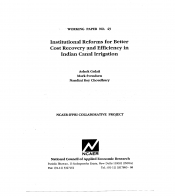Institutional reforms for better cost recovery and efficiency in Indian canal irrigation
Ashok Gulati
Mark Svendsen
Nandini Roy Choudhury
July 1994
The Indian irrigation network is one of the largest in the world. But the productivity of these large numbers of surface irrigation schemes is nowhere near optimal and one of the main reasons ascertained for this is poor financial and physical management. In fact, in the current scenario of inflated costs,poor costs and poor cost recovery, the government is finding it impossible to sustain its irrigation development efforts. In order to correct this anomaly and improve management, it has become imperative to bring about a change in the institutional structure of this sector. The government has already taken some steps towards this by encouraging formation of user’s association to manage sections of major or medium schemes. But such isolated efforts are not proving to be enough and in this context this paper looks at these isolated efforts, as well the experiences of various nations which have been successful in developing efficient irrigation systems. Most of these successes are found to be either wholly or partially financially autonomous and this, in fact, appears to be the key to efficient management of these systems. This paper makes a modest attempt at putting forward certain suggestions for improved functioning of the irrigation sector, based on the experiences of the various states of India and other countries like Philippines, Korea, China etc.
Agriculture and Rural Development







